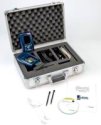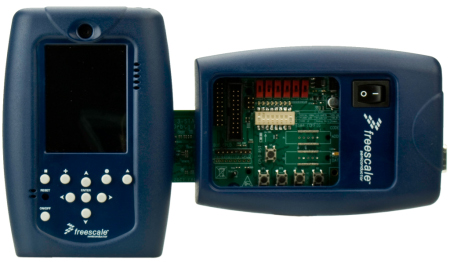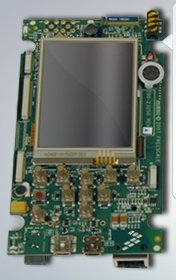ARM11 SoC gains dev kit
Jun 17, 2008 — by Eric Brown — from the LinuxDevices Archive — 7 views Freescale Semiconductor is shipping a product development kit (PDK) for its ARM11-based i.MX31 system-on-chip (SoC). The kit includes a CPU module, a “Personality” (peripherals) module, a debugging device, and board support packages (BSPs) for either Linux or Windows CE.
Freescale Semiconductor is shipping a product development kit (PDK) for its ARM11-based i.MX31 system-on-chip (SoC). The kit includes a CPU module, a “Personality” (peripherals) module, a debugging device, and board support packages (BSPs) for either Linux or Windows CE.
(Click for larger view of i.MX31 PDK)
Clockable from 532MHz to 665MHz, the i.MX31 first shipped in 2005. It was soon found in a variety of applications including consumer, automotive, industrial, and general embedded markets. Freescale's three-stack PDK is the first in the company's history, which is a testament to the popularity of the multimedia-friendly i.MX31. It is also a sign that the company plans to continue to ride the i.MX31 horse, despite recently announcing what appears to be its heir: the more power-efficient i.MX37.
The i.MX37 is based on a ARM1176JZF-S core, compared to the i.MX31's ARM 1136JF-S. The company's i.MX27 processor, announced last June, and its i.MX21, introduced in 2004, are both based on the widely used ARM926EJ-S core.

Left to right: Personality Module (with CPU Module embedded) and Debug Module
(Click to enlarge)
The i.MX31 PDK is comprised of three separate, reusable modules that work together:
- CPU module — single board computer (SBC) containing the i.MX31, as well as Freescale's MC13783 power management IC, and memories. The MC13783 is said to offer numerous power saving modes, enabling trade-offs between power consumption in stand-by and recovery times. Touted features include:

CPU Module (open)
- i.MX31 applications processor
- 128MB DDR SDRAM
- 256MB NAND flash
- PMIC MC13783 with associated power circuitry
- Audio
- HS USB PHY
- Touch controller
- Connector
- Personality Module — a peripherals board with a 2.7-inch TFT display that manages functionality including touchscreen, sensors, and wireless connectivity technologies. The module is also equipped with Freescale's MMA7455L 3-axis digital accelerometer, which offers motion detection that is said to support gesture recognition, tilt to scroll in all directions, or silencing the phone by tapping it. Specific features include:

Personality Module (open)- 2.7-inch TFT display
- MMA7450L acceleromater
- User I/O
- FM
- 802.11 (WiFi)
- Bluetooth
- USB OTG, USB HS
- Button
- 2-MegaPixel camera module
SD card, ATA HDD - External connectors: dock, headphones, TV out, GPS
- Microphone, speaker
- Debug Module — a common interface between the CPU and Personality modules that includes ports, interfaces, and interconnectons with other devices. Features include:

Debug Module (open)
(Click to enlarge)- Debug Ethernet port
- Debug Serial port
- JTAG
- Reset, interrupt, boot switches
- Debug LEDs
- CodeTest interface
- Power source
- Current/power monitoring
The i.MX31 Linux BSP includes a multimedia framework, demo applications, and wireless connectivity protocol stacks, says Freescale. Additional software, including multimedia codecs, are said to be available for download on the i.MX website.
Stated Aaron Shagrin, director of business development, Freescale, “This initial Product Development Kit offering opens the door to entirely new classes of intelligent, connected devices.”
Availability
The i.MX31 PDK is available now for $2,500, with a choice of BSPs for Linux 2.6.24, Windows Embedded CE 5.0, and Windows Embedded CE 6.0, says Freescale. A limited-time, 25-percent discount is currently available.
Freescale will be demonstrating the PDK at its Freescale Technology Forum, on June 16-19 in Orlando, Florida. The company will also be demonstrating prototypes of its “QorIQ” line of communications processors that it announced yesterday. More information on the PDK may be available here.
This article was originally published on LinuxDevices.com and has been donated to the open source community by QuinStreet Inc. Please visit LinuxToday.com for up-to-date news and articles about Linux and open source.